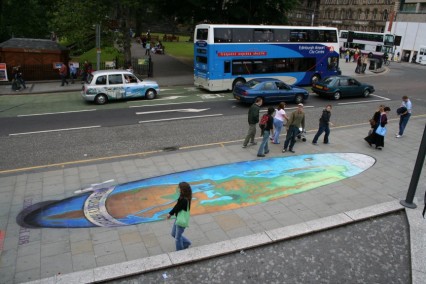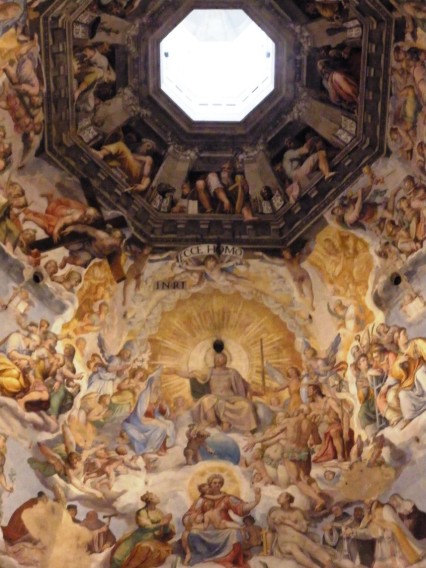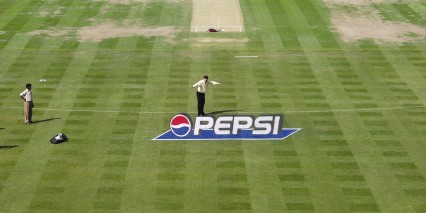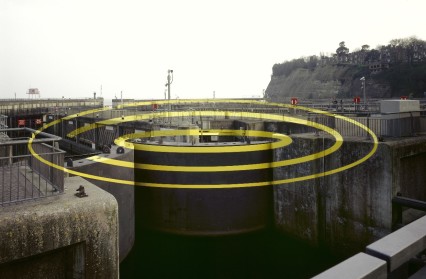Richard Porch discusses anamorphic images and their presentation in various public spaces throughout Wales and the world.
From Holbein to a sports ground near you…
I am always on the lookout for instances when we contrive to find a new use for an old idea, especially when it involves art.
 Such an idea involves the optical effect known as anamorphosis. An anamorphic image is the name given to an image created by distorted projection or perspective which requires the viewer to occupy a specific vantage point in order to ‘read’ the image properly. You can have perspectival anamorphosis or mirror anamorphosis. The latter, as its name implies, uses a mirror placed on the drawing or painting to convert a flat distorted image into an understandable picture.
Such an idea involves the optical effect known as anamorphosis. An anamorphic image is the name given to an image created by distorted projection or perspective which requires the viewer to occupy a specific vantage point in order to ‘read’ the image properly. You can have perspectival anamorphosis or mirror anamorphosis. The latter, as its name implies, uses a mirror placed on the drawing or painting to convert a flat distorted image into an understandable picture.
Without really realising it the commonest one we are used to seeing is Holbein’s painting of 1533 ‘The Ambassadors’. It depicts two wealthy and well-travelled (as the globe hints) young men who stand within a painting populated with other symbols of their wealth and position. It is not the purpose of this article to explain the nature of the painting’s varied iconography.  This can be separated out and understood as a completely different and fascinating agenda. More informed people than me suggest that the icons stand for religious harmony and can even be pinned down to the religious festival of Easter. The picture is quite conventional for its time except for one feature which intrudes from the bottom left and finishes at the centre-middle of the work. To the naked eye it is unintelligible and resembles some odd sort of graphic shape and serves no purpose or apparent symbolic value.
This can be separated out and understood as a completely different and fascinating agenda. More informed people than me suggest that the icons stand for religious harmony and can even be pinned down to the religious festival of Easter. The picture is quite conventional for its time except for one feature which intrudes from the bottom left and finishes at the centre-middle of the work. To the naked eye it is unintelligible and resembles some odd sort of graphic shape and serves no purpose or apparent symbolic value.
It is a plane anamorphic image and can only be interpreted visually by standing at a given angle to the painting. When the onlooker does this – all is revealed. For, by using a plane anamorphic technique, Holbein inserted the disguised image of a skull which symbolically represents death. The artist put it there to remind us that in spite of whatever worldly success we might enjoy and riches we might accrue; death awaits us all at some point. This is the essence of the plane anamorphic image; it is a distorted image that can only be understood from one angle. Holbein used it as the medium for a secret message but it can also be used to overcome limitations of location.
 Anamorphic images have been employed less dramatically in art, most notably when painted onto the ceilings of churches during the Renaissance. They depicted religious scenes and were designed to be looked at from the floor of this or that church or cathedral. To do this and make them distortion-free they had to be painted as anamorphic images. Coming more up to date, during the 18th and 19th centuries anamorphic images were more often deployed as an optical prank or parlour game for domestic consumption. Most latterly they have been regenerated for use in public art projects (the Swiss artist Felice Varini did one in Cardiff Bay in March 2007). They work best as a modern re-working of their intrinsic appeal, i.e. the ‘concealment’ of an image in plain sight. They have been deployed as purely decorative street art both here and abroad whose aim is to do no more than stop people in their tracks and make them gape. Which is fair enough.
Anamorphic images have been employed less dramatically in art, most notably when painted onto the ceilings of churches during the Renaissance. They depicted religious scenes and were designed to be looked at from the floor of this or that church or cathedral. To do this and make them distortion-free they had to be painted as anamorphic images. Coming more up to date, during the 18th and 19th centuries anamorphic images were more often deployed as an optical prank or parlour game for domestic consumption. Most latterly they have been regenerated for use in public art projects (the Swiss artist Felice Varini did one in Cardiff Bay in March 2007). They work best as a modern re-working of their intrinsic appeal, i.e. the ‘concealment’ of an image in plain sight. They have been deployed as purely decorative street art both here and abroad whose aim is to do no more than stop people in their tracks and make them gape. Which is fair enough.
Perhaps most intriguingly they have found a new and lucrative role as a way of sneaking advertising space onto the playing surface at major sporting events. If you’ve been to virtually any cricket, football or rugby game of any significance in the last 5 years you will have seen plane anamorphic images deployed precisely because of their ability to look three-dimensional whilst really being two-dimensional. To the uninitiated they look like hoardings bearing this or that logo or brand message. They are usually laid either side of the goal or are painted onto the centre circle where play is started and re-started.
They register on the eye as if they are a three-dimensional feature (like an advertising hoarding) but are a plane anamorphic image that has been printed onto a two-dimensional mat or sprayed onto the pitch Two examples have been reproduced within this article. What they enable the advertiser to do is get the brand logo onto the television screen and as close to the action without presenting a physical danger to the players. They only work from the principal camera location – i.e. head-on – and cannot really be understood from any other part of the ground.
 This made me think whether plane anamorphic images have a wider application than in mere advertising and whether they could be deployed in a way that was both decorative and practical. I live on a modern housing estate and the main body of housing is reached via a long tree-lined driveway on which there used to be three ‘sleeping -policemen road bumps’. These very successfully reduced the speed of incoming traffic to the estate in a direct and physical manner.
This made me think whether plane anamorphic images have a wider application than in mere advertising and whether they could be deployed in a way that was both decorative and practical. I live on a modern housing estate and the main body of housing is reached via a long tree-lined driveway on which there used to be three ‘sleeping -policemen road bumps’. These very successfully reduced the speed of incoming traffic to the estate in a direct and physical manner.
When the road was re-surfaced a while ago the humps were taken out and not replaced. Traffic however still tends to slow down at the locations where the three speed bumps used to be – the drivers are obviously responding out of sheer force of habit or learned behaviour. I’m wondering whether physical calming measures like speed bumps could be replaced with plane anamorphic images painted into the road surface? Could simple painted designs slow drivers down by presenting some sort of apparent obstacle or barrier that would induce them to reduce their speed? Or could something purely decorative be done which forced drivers to reduce speed in order to subliminally register it? Obviously research would be needed to see what would be acceptable and safe; something abstract or something recognisable?
Four hundred and eighty-two years on from Holbein’s inspired use of an anamorphic image in a painting – I still think the idea looks good from any angle…
(Header image is of Felic Varini’s Cardiff Bay artwork of 2007)
Richard Porch is a regular contributor to Wales Arts Review.












